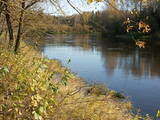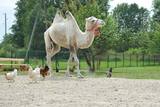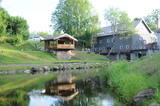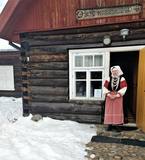| Nr | Nosaukums | Apraksts |
|---|---|---|
|
Atrodas Grobiņas nomalē (dienvidaustrumdaļā) pie Liepu gatves (saukti arī par Priediena senkapiem). Arheoloģisko izrakumu rezultāti liecina, ka apbedījumi te skeletkapu, ugunskapu un uzkalniņkapu veidā tapuši laikā no 7. - 9. gs. (atšķirīgi datējumi, arī 4. – 10. gs.) 1987. g. izrakumu laikā te atrada unikālu ar seniem ornamentiem rotātu 8. - 9. gs. skandināvu karavīra kapakmeni (stēlu), kas glabājas Liepājas vēstures un mākslas muzejā un ir vienīgais šāda veida atradums Baltijas jūras dienvidaustrumos. 0,3 km dienvidos no senkapiem lēnām plūst Ālande, kas viduslaikos bijusi kuģojama. Liepas gatves malā uzstādīta informatīva zīme. Grobiņas arheoloģiskais ansamblis ir iekļauts UNESCO Latvijas nacionālajā sarakstā. |
||
|
Sāremā salas augstākā (līdz 21 m), iespaidīgākā un ainaviskākā klinšu siena, kas stiepjas ~ 3 km garumā. Stipra R, ZR vēja laikā tās nelielu posmu apskalo jūras viļņi. Atsegumu veido Silūra perioda kaļķakmeņi, merģeļi un dolomīti, tādēļ to piekājē izskalots bagātīgs fosiliju klāsts – koraļļi, galvkāji, stromatopori u.c.
|
||
|
Teritorija, kas aptuveni 20 km garumā „piekļāvusies” abiem Aiviekstes upes krastiem. Dabas parka galvenā vērtība ir palieņu pļavas (un citi pļavu biotopi), kas ir ļoti nozīmīga daudzu augu un dzīvnieku (īpaši – putnu) sugu dzīves vieta. Ūdenstūristiem, kas laivo pa Aivieksti, nakšņošana ir jāplāno tikai šim mērķim paredzētās vietās!
|
||
|
Eksotiskajā dzīvnieku parkā var apskatīt dažādus dzīvnieciņus, t.sk. lamas, alpakas, mini ponijus, pundurcūciņas, briedi, hailanderu, pundurkaziņas, aitu cūkas, dažādus trušus, Āfrikas melnos strausu, un kur nu bez divkupru kamieļa un Latvijas zilās govs, un dažnedažādiem putniem! Tas būs skaisti pavadīts brīvais laiks dzīvnieku sabiedrībā, vērojot viņu dzīves ritmu , barojot ar saimniecības sarūpētu barību. |
||
|
Saimniecība atrodas skaistā vietā, šeit var dabūt garšīgu ēdienu, un tai ir jauki saimnieki. Viesiem tiek piedāvāta arī naktsmītne un sauna. Saimniecībā nodarbojas gan ar lauksaimniecības produktu audzēšanu, gan to tālāko apstrādi. |
||
|
Igaunijas galvaspilsēta. Vecpilsēta (UNESCO Pasaules kultūras mantojuma sarakstā) - izcils viduslaiku (14. – 15. gs.) apbūves piemineklis. Bijusī Hanzas pilsēta. |
||
|
Musteikas pirmsākumi ir meklējami jau 18. gs. Līdz Musteikai no Marcinkones puses var nokļūt pa grantētu ceļu, kas ved gar bijušajiem kolhoza zivju dīķiem. Automašīnu var atstāt ciema sākumā un izstaigāt to ar kājām, izjūtot veco ēku smaržu un šarmu. Musteikā atrodas Dzūkijas biškopības vēsturei veltīts „dzīvs” muzejs, kur stropos dzīvo bites, bet tā saimnieks ir biškopis pēc aicinājuma un būtības. Ja palūgsiet, viņš demonstrēs – kā ar krama, metāla un posas piepes palīdzību senos laikos ieguva uguni. |
||
|
Sena sēta pie upes, kur jau kopš 1851. gada darbojas ūdens dzirnavas. Skaista ainava - blīvs mežs, milzīgs dīķis un upe. Viensētā ir tradicionālš lietuviešu pirts, kur izbaudāmi autentiski pirts rituāli profesionāla pirtnieka pavadībā. Vieta, kur sarīkot ģimenes svinības vai korporatīvo pasākumu - semināru vai banketu. Zālē var tikt uzņemti līdz 40 cilvēki. Piedāvā nakšņošanu 10 istabās. Aktīvās atpūtas piekritēji var doties pārgājienos ar kanoe, zvejot līdakas, izbraukt ar velosipēdu pa Varniu reģionālo parku, apmeklējot senās baznīcas, pilskalnus un muzejus. Ir iespēja palikt arī teltī. Ekskursija pa 19. gs. dzirnavām ar stāstījumu par tā laika graudu malšanas procesu.
|
||
|
Saimniecībā, kura atrodas pašā Sēlijas novada centrā, aug un zied vairāk nekā 400 dažādu rožu šķirnes, kā arī siltumnīcās tiek audzēti dažādi dārzeņu un puķu stādi. Iegādei tiek piedāvāti dažādi viengadīgie augi, vairāki simti rožu stādi un ēdamaugu stādi siltumnīcai un dārzam. |
||
|
Kihnu ir vislielākā sala Rīgas līcī (16,4 km2), tā ir 7 km gara un 3,3 km plata. Uz salas ir trīs ciemi. Izbaudīt unikālo atmosfēru ir iespējams apciemojot vietējo ģimeni fermā "Kuraga". Trīs paaudzes dzīvo šai fermā un būs priecīgas uzņemt jaunus viesus. |
||
|
Saimniecībā lielās platībās audzē ogulājus, iegūto ražu pārstrādājot sulās, ievārījumos un marmelādēs. Nodarbojas arī ar mājas vīna izgatavošanu. Apmeklētājiem piedāvā ekskursiju pa dārzu un vīna pagrabu, iespējams degustēt vīnu, kā arī iegādāties vīnu, konfektes un marmelādes. |
||
|
Setomaa has been inhabited for about 8,400 years, which makes it one of the oldest human settlements in Estonia. It is located on the border of Eastern and Western civilisations, bordering Russia, Latvia and Estonia. Setomaa is famous for its well-preserved traditions and culture. For centuries the local handicraft skills have been passed down within families. Seto polyphonic singing (Seto leelo) is inscribed on the UNESCO List of the Intangible Cultural Heritage of Humanity. Setos have distinctive national costumes, rich in detail and unique to each family. Perhaps most impressive is the distinctive array of Seto jewellery. These visually striking pieces not only reflect the social standing of the wearer but are also worn as a safeguard from misfortune. To this day, the Seto lifestyle remains closely tied to nature. It is common practice for the Seto not only to enjoy the natural beauty of the forest but to also use its gifts. Berries and mushrooms are picked freely in their seasons. It is best to start the tour from Võru and finish in Tartu. |
||
|
Maršruts ilgst 12 dienas, ar privāto auto transportu. Kopējā maršruta distance ir 1 500 km. |
||
|
Darbnīcā top saimniecībā noderīgas lietas – terīnes, gurķu skābējamie podi, cukura un sāls trauki, bļodas u.c. Apmeklētājus iepazīstina ar podniecības tradīcijām un aicina uz cepļa atvēršanu. |
||
|
Maršruts sākas populārākajā Latvijas kūrortā - Jūrmalā. Tas piemērots gājējiem, kam patīk iet gar jūras krastu, kur mijas gan ar savdabīgo piekrastes šarmu apvītie bijušie zvejniekciemi, gan mazskartas un vientuļas pludmales. Daudzviet ciemos darbojas mazas lauku kūpinātavas, kur ceļotājiem piedāvā žāvētas zivis. Maršruta galamērķis ir Kolkasrags, ko slavenais Latvijas jūrskolas dibinātājs Krišjānis Valdemārs uzskatīja par Eiropas centru. Kolkasrags kā viena no Baltijas jūras bīstamākajām kuģošanas vietām ir pazīstams jau no vikingu laikiem. Kolkasrags ir arī viena no Latvijas putnu vērošanas „top” – vietām. Maršruta informācija no Latvijas Lauku foruma |
||
|
Saimniecībā pēc senām vecmāmiņas receptēm uz kļavu lapām cep smaržīgo Kalēja saldskābo un Kalēja rudzu maizi, kuras kraukšķīgo garozu apstrādā ar linu eļļu. Piedāvā dalību maizes cepšanas procesā, degustāciju un iegādi. Ir kafejnīca - latviskas virtuves ēdieni, grupu ēdināšana, plaša ēdienkarte, galdu klāšana. Āra terase, piknika vieta, grils, ugunskura vieta, telts vietas. Banketu zāles 100 un 60 personām. |
||
|
Baltijā lielākās HES celtniecību uzsāka 1961. g., bet pabeidza 1966. g. Tajā uzstādīto 10 hidroagregātu projektētā jauda bija 825 MW. Pļaviņu HES tiek uzskatīta par unikālu, jo pirmoreiz HES būvniecības praksē tā konstrukcija tika balstīta uz mālsmilts un smilšmālu gruntīm ar maksimālo spiedienaugstumu - 40 m! Pļaviņu HES ēka ir apvienota ar ūdens pārgāzi, zem kuras atrodas Latvijas garākais tunelis - Enerģētiķu iela. 20. gs. deviņdesmitajos gados Pļaviņu HES rekonstruēja un tagad tās jauda ir sasniegusi 870 MW. Apmeklētāji var iepazīt mašīnzāli, skatu laukumus un HES maketu. |
||
|
Viesu nams atrodas skaistā, mierīgā vietā pie dīķa, kas ikvienu zvejnieku iepriecinās ar zivju pārpilnību. Viesi tiek izmitināti 120 gadus senā klētī, kurā ir guļamistabas, virtuve un pirts. |
||
|
Saimniecībā nodarbojas ar biškopību. Piedāvā bišu produktus un bišu vaska sveču liešanu, kā arī izbraucienu ar 4/4 automašīnu pa bezceļa trasi, pirti un nakšņošanu. Degustācijai medus maisījumi. Īpašais piedāvājums - mājās cepta maize ar medu. Ar izglītojošu programmu pēc pieprasījuma izbrauc uz skolām un pasākumiem.
|
||
|
This study tour is designed to show Latvia's rye traditions as their central focus. This tour has been developed in cooperation with the Latvian Bakers’ Association. Rye is both the basis of the Latvian diet and a powerful symbol of Latvia's culture and culinary traditions. Itinerary emphasize traditional rye bread-baking and eating, as well as insights into the history of the rye grain from Latvia's earliest archaeological record to the present day. Itinerary include visits to working farms, grain mills and culturally and historically important locations. This study tour is designed for groups and may be adapted to the needs, interests and timeframe of each client. Tour cost includes meetings with experts, site visits and admissions, accommodations, specified meals, sightseeing, transportation within Latvia and guides-interpreters. |
||


























